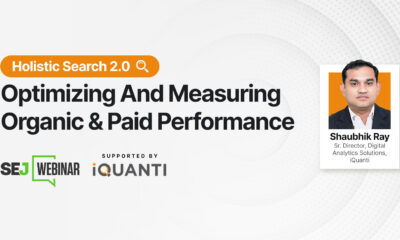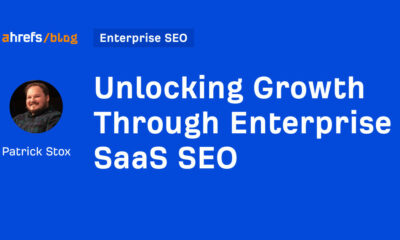SEO
Why Your Agency’s Growth Is Limited & How To Fix It

If you’re looking for sustainable growth opportunities and meet the following criteria, you’re in the right place.
- Your agency has not reached the multi-million dollar mark yet.
- Your agency is directly responsible for PPC fulfillment.
- PPC is not your agency’s most lucrative offering.
Those are the primary factors contributing to The PPC Dilemma, creating the untapped potential for digital marketing companies.
Below is an explanation of The PPC Dilemma and its remedy so you’ll have an effective means for scaling your agency.
The PPC Dilemma Explained
Digital marketing agencies must deliver high-quality PPC to attract and retain the right clients. However, resources are limited, and PPC is typically not the most significant profit driver.
Agencies must provide it, which inevitably diverts resources from more valuable activities.
That’s The PPC Dilemma.
The Economics Behind The Dilemma
There is no need to be alarmed or try to skip class.
This is not a lecture on economics.
That being said, the link between The PPC Dilemma and this well-trusted social science will help you implement this solution with confidence.
Thankfully the connection is pretty straightforward, so this will just take a minute.
Economies Of Scale
The “multi-million dollar mark” qualifier referenced above is based on an understanding of economies of scale.
According to Will Kenton’s article in Investopedia,
“Economies of scale are an important concept for any business in any industry and represent the cost-savings and competitive advantages larger businesses have over smaller ones.”
Multi-million dollar agencies who enjoy economies of scale are likely not suffering from The PPC (pay per click) Dilemma described below and won’t qualify for the corresponding growth opportunity.
Translation: If you are not an Inc 5000 agency, keep reading.
Diminishing Returns
To understand The PPC Dilemma is to understand the law of diminishing returns, which observes that output suffers when factors of production increase.
Key Terms Defined & Personalized:
- Output: These are your deliverables, which generate revenue for your agency.
- FOP (factors of production): Any resource you use to produce your services.
Your FOP includes all of the resources required to fulfill each of your agency’s offerings, e.g., SEO, web design, PPC, etc.
What Did I Say?
I told you that would be painless.
The bottom line (so far) is this: Your factors of production should include PPC fulfillment if PPC is your most lucrative offering; otherwise, it’s hindering your growth. That may be current or future growth, depending on when you reach optimal capacity.
Either way, you will grow if you can mitigate PPC fulfillment from your agency’s production factors while continuing to profit from its output/deliverables.
Now that I have demonstrated the “what” of The PPC Dilemma, I will get into the practical side of how to fix it.
The Big Four PPC Fulfillment Options
So how do agencies deliver high-caliber PPC while keeping its associated factors of production lean?
Below is a list of the most viable PPC fulfillment options with pros and cons.
Determine which one enables you to eliminate PPC fulfillment as an FOP while continuing to profit from its deliverables in your output.
Existing In-House Talent
This fulfillment method tasks existing staff (current employees with additional responsibilities) with managing PPC accounts.
Pros:
- Accountability – Employees have a high degree of liability to their employers, resulting in a strong motivation to do a great job.
- Control – The ability to determine your PPC manager’s schedule, bandwidth, etc.
- Communication – Internal staff typically have quick response times.
- Fluidity – Internal teams fully integrate with existing tools and processes.
- Commitment – Employers enjoy loyalty from staff, assuming a healthy work culture is in place.
Cons:
- Disruption – According to a recent study by the U.S. Bureau of Labor Statistics, employee turnover is historically high. Employee churn will create a lot of turbulence in this eggs-in-one-basket model.
- Demand – You are responsible for developing and maintaining the infrastructure necessary to execute PPC fulfillment effectively.
- Limited Results – Existing staff have additional responsibilities beyond PPC management. They also have less experience than dedicated talent who concentrate strictly on PPC. Performance suffers as a result.
- Burnout – The more hats employees must wear, the more prone they are to experience burnout.
Dedicated In-House Talent
This option refers to hiring full-time specialists specifically for managing paid media.
Pros:
- All the benefits listed in “existing in-house talent,” plus:
- Performance – You’ll experience better results when leveraging a dedicated specialist because they will have more experience and be able to focus all of their time on that one area.
- Bandwidth – The bandwidth of this model excels both existing in-house talent and contractors.
Cons:
- The disadvantages listed in the first model (except for burnout), plus:
- Recruiting – Headhunting is challenging, especially in today’s competitive market. It is time-consuming, and there are also a lot of uncertainties when onboarding a brand new employee.
- Obligation – With salaried employees (vs. project-based), you are committed to a high monthly operational cost regardless of the workload of the individual. Similarly, you are committed to that cost indefinitely, irrespective of the term of their projects.
- Limitations – Unless you have $12,000 to $13,000 per month to spend on multiple specialists, you will have to settle for someone who handles both paid search and paid social. This results in a reduction in skills compared to channel-specific specialists who are laser-focused on one channel.
Hiring Contractors
This fulfillment method involves independent individuals who do not work exclusively for one person or business.
Pros:
- Economical – This is a cost-effective method because 1. You only pay for specific projects (accounts), and 2. Contractors typically have limited overhead costs.
- Control – While the level of control in this model can’t compete with the in-house models, there will be more flexibility here than working with an organization.
- Flexibility – Contractors do not come with long-term obligations.
- Talent – This economical option enables you to hire channel-specific specialists versus a generalist who manages paid search and paid social.
Cons:
- Risk – There is an inherent vulnerability with hiring contractors due to the independent nature of their position.
- Lack of commitment – This is the other side of the flexibility coin, e.g., you have an individual servicing multiple agencies.
- Communication – Communication gaps are inevitable when one individual manages multiple clients (agencies), each with their accounts.
- Accountability – Independent contractors have the least amount of accountability.
- Mediocrity – Innovation is uncommon in this model due to the natural constraints of a single individual.
- Disruption – Like either of the in-house scenarios, it is disruptive when this person exists stage left. Remember that contract work does not carry the same unspoken expectation of a two-week notice.
White-Label PPC
With this fulfillment method, your agency purchases a white label company’s services and offers them to your clients under your brand.
Pros:
- Cost-effective – Hiring an outsourcing partner eliminates payroll and reduces costs associated with recruiting, infrastructure, workspaces, and resources.
- Performance – A reputable white label PPC vendor will provide optimal performance. The reason for this is two-fold: 1. Given that they manage millions of ad spend at scale, they will have a lot of data, automation, etc. 2. They will have channel-specific specialists vs. paid media generalists.
- Stability – This is the only model that provides immediate, alternative specialists during churn. They have other acclimated specialists who can step in to minimize the impact during transitional phases.
- Low commitment – Like contractors, you never have to worry about idle, paid staff when a project ends as you only pay for active services.
- Accountability – White-label PPC companies come with their brand and upper management, which means specialists are held to high standards.
- State of the art – In addition to the specialists managing your accounts, a white-label provider will have leadership dedicated to continually improving their service.
- Turnkey – I know of one vendor that empowers agencies to efficiently white-label PPC management at scale across the entire client journey through one dynamic interface. A robust client portal that isn’t limited to simple functions like submitting a support ticket is a big deal if you have multiple accounts.
Cons:
- Additional tools – You can’t expect an organization dedicated to white label PPC to integrate with your systems. You will need to acclimate to additional tools.
- Minimal control – White label providers already have their service level agreements in place. The result is that you can’t dictate or amend their processes.
- Communication – There is simply no way to replicate the responsiveness of in-house staff.
Note: The disadvantages here could easily be longer depending on your chosen vendor. I assume that the white label provider 1. has full-time W2 employees who reside in your country; 2. does not take over ownership of your assets (ad accounts, landing pages, etc.), and 3. has channel-specific specialists, e.g., paid search specialists and paid social specialists.
Four Tips For Success
These are the most common PPC fulfillment options available to agencies.
You’ll want to identify which one will provide your agency with the most potential for scalability.
I’ve provided four tips to help you identify the most effective model to resolve The PPC Dilemma.
1. Properly Weight Your FOPs
The most effective option will be the one weighed toward your agency’s most lucrative offerings.
In other words, when it is all said and done, your FOPs should be dominated by activity related to your wheelhouse/flagship offering.
Consider asking yourself, “Which model will minimize PPC fulfillment’s production factors while still allowing us to profit from its output/deliverables?”
2. Be Proactive
When confronted with opportunities like this, it is easy to be ruled by the tyranny of the urgent.
Don’t limit yourself to thinking about what would help you now; consider your potential 6 – 12 months from now.
To flesh this out, imagine yourself 12 months from now saying, “I wish I would have __________,” and then take measures to avoid that regret.
3. Don’t Underestimate PPC
Many aspects of an agency are evaluated, but few are as important as PPC.
Consider the number of users on Google and Facebook, the high level of intent associated with PPC, and the unmatched control over marketing dollars available to advertisers.
This is not a facet of digital marketing that you want to take lightly.
4. Remember Opportunity Cost
Instead of looking strictly at direct costs, remember to respect and factor in opportunity costs when making strategic decisions.
When we emphasize secondary priorities, we miss opportunities to zero in on what most contributes to our success.
This can be likened to the inverse of diminishing returns.
Make A Confident Decision
In his book, “From Good to Great,” Jim Collins observed that you need to confront the facts to make good decisions.
There are fewer effective ways to do this than basing decisions on proven scientific laws.
You can relax and make a call that economists back.
If appropriately executed, you can look back 12 months from now with a strong sense of satisfaction, knowing you made a wise move.
Here’s toward your future, sustainable growth!
More resources:
Featured Image: Golubovy/Shutterstock



















You must be logged in to post a comment Login